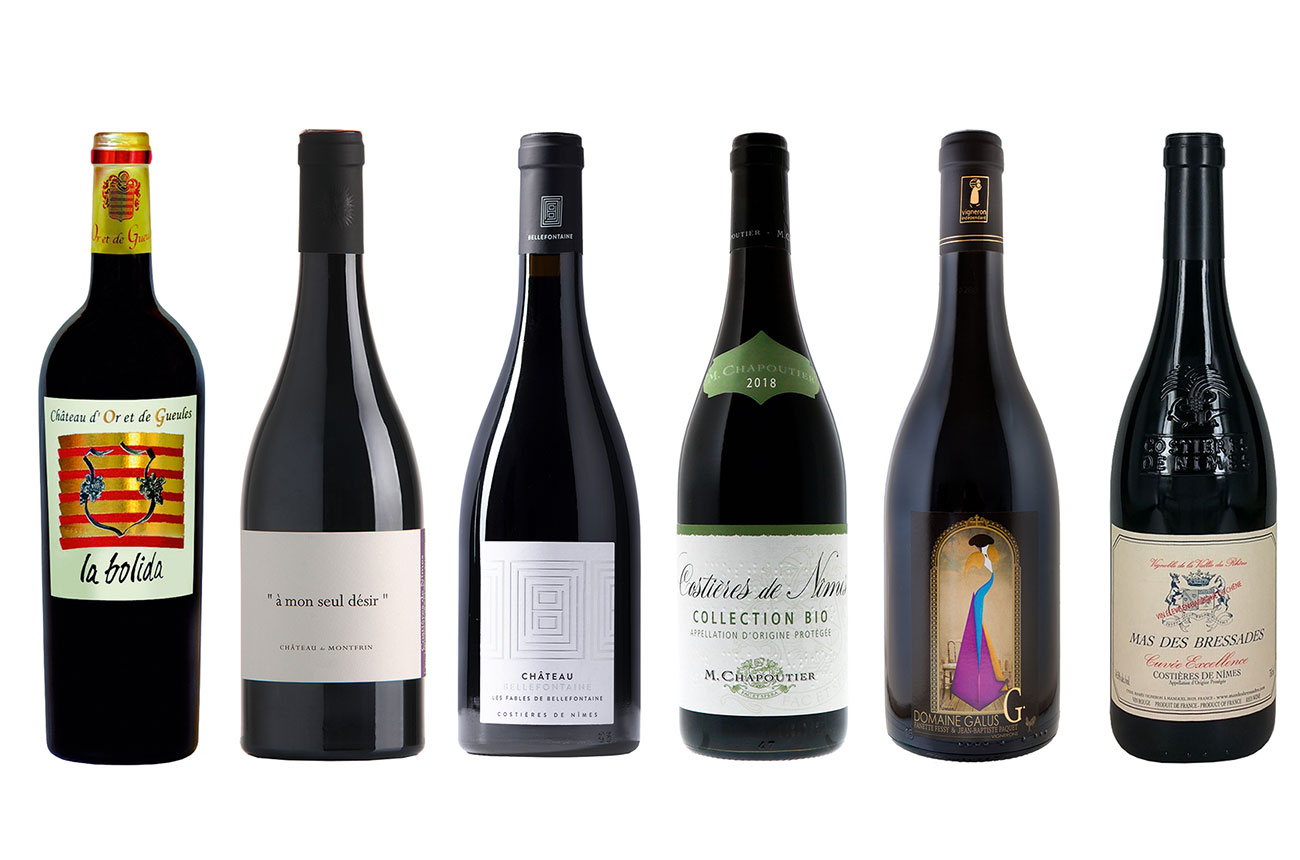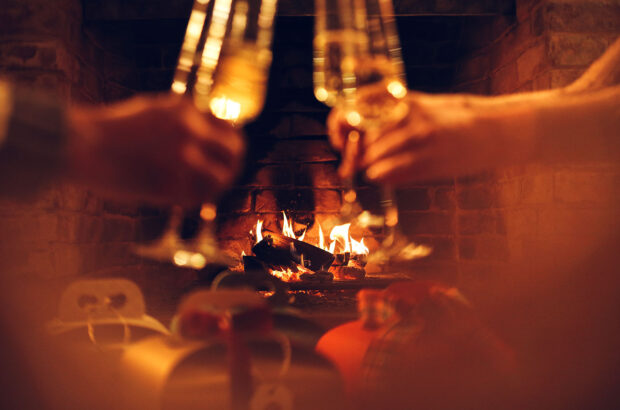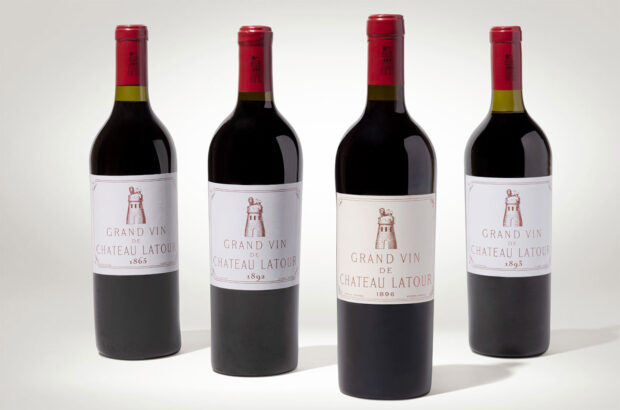It’s only an hour’s drive from Avignon, but the further you wade into Costières de Nîmes, the more you feel the difference. Giant saw-toothed pampas grass guard the roadsides like policemen built from blue-green armoured plates. While white horses scatter as you pass. This is no longer Provence; this is the Camargue, the Rhône’s sprawling delta as it feeds into the Mediterranean. And just as it has its own landscape and culture, you hear a different accent in the wines; still typical of the region, but with a fresh, estuarine tang.
Ripples through the centuries
The appellation was granted in 1986, but this area has been renowned for its wines for centuries. The Greeks started developing vineyards here in the 5th century B.C., and the Romans built on their work. Wine amphorae produced in the area have been found as far afield as Italy, which proves that these wines weren’t just for local consumption – they were valuable enough to export. In the Middle Ages, as is so often the case in France, the monks picked up the baton; first the Benedictines, then the Cistercians. Later on, several abbeys would supply their wines to the Avignon popes.
By the 17th century, the wine industry was booming; the Canal du Midi and the railways helped to ferry the wines to new markets. The vineyard area spread to over twice what it is today. But after phylloxera struck, it took time for the region to bounce back.
The renaissance started in the 1950s with the work of Philippe Lamour, who helped spearhead a new project of canals and waterways that channelled water from the Rhône to feed plantations of fruit trees and new vineyards. The fields are often greener here than further north, you sense the moisture in the air.
Costières de Nîmes in brief
- Location: Rhône Valley vineyards appellation 35km southwest of Avignon
- AOC created: 1986
- Production: All three colours: red, rosé and white
- Principal grape varieties for reds and rosés: Syrah, Grenache, Mourvèdre Principal grape varieties for whites: Grenache Blanc, Roussanne, Marsanne
- Colours made in 2020: 43% red, 48% rosé, 9% white
- Climate: Mediterranean, sunny with cooling sea breezes and mistral (north wind)
- Prevailing soil type: large pebbles over red clay
- Total surface area producing Costières de Nîmes in 2020: 2,837 hectares
- Annual production in 2020: 153,000 hectolitres
- Average yield in 2020: 53hl/ha Private estates: 71
- Co-operative wineries: 9
Maritime influence
Costières de Nîmes certainly has its own distinctive character, but you need only to look down to your feet to see its umbilical link to the Rhône river. Rounded galets roulés over clay limestone stretch for as far as the eye can see. The word costière refers to this undulating raised bank of pebbles in fact. These are the same Villafranchian deposits found in Lirac and Châteauneuf, carried by the Rhône and Durance rivers from the Alps.
It’s a substantial appellation covering 24 villages, and there are two distinct styles of wine; the north and south. Both areas take their names from established abbeys, the north being Saint-Roman, a Benedictine abbey dating back to the seventh century and the south, Franquevaux, a cistercian abbey dating back to the 13th century.
Saint-Roman is largely flat and sits at around 60m above sea level. There’s a little more limestone and loess in the soils here, and the dominant wind is the boisterous northerly mistral. Reds wines are concentrated and spicy. The southern part is called Franquevaux, which gently slopes down to the sea. The pebbles here are a little smaller, and the prevailing wind is the dewy marin, a south wind that rolls in over the Mediterranean sea. These reds are soft, elegant and juicy.
For now at least, these two areas aren’t officially recognised as geographical subdivisions on labels, but it’s likely that they will be at some stage in the future.
These are the southernmost vineyards of the Rhône Valley, but paradoxically they are also some of the coolest. This is easily explained. When the summer sun gradually heats up this enormous bank of pebbles during the day, it causes hot air to rise. This sucks in cool sea air, which drops afternoon temperatures by 3 to 4°C. The proximity to the sea also makes for cooler nights, which helps to retain fresh aromatics in the wines.
Since the early 2000s, the appellation has adopted a number of programmes to promote sustainable and organic farming, and now a remarkable 25% of the vineyard area is certified organic – well above the regional average.

Credit: Charlène Pélut
Three colours – and a secret speciality
Grenache is widely planted here, but the dominant red grape is Syrah, which is well-suited to the cooler climate. It brings a certain straightness, structure and subtle spice to the wines. Mourvèdre is also popular; its synonym ‘Plant de Saint-Gilles’ refers to the village of Saint-Gilles in the southern part of the appellation next to wide coastal ponds near the sea. It offers depth, structure and ageability to the blend. As does Carignan; Cinsault and Marselan add a little freshness and lift.
The Rhône Valley vineyards are often associated with, full-bodied, fireside red wines but red Costières de Nîmes tend to be a little less bulky, their fruits not quite as dark as some. Red berries and plums are more common, as are fresh herbs like sage and rosemary, and even a little seaweed.
Reds make up almost half of all wines made here, but rosé isn’t far behind, with 48% of production. They use the same grapes as the reds and are typically pale in colour, with raspberry and strawberry fruits, made in an aperitif style – lighter than some of the region’s rosés.
White wines may only make up 9% of the total, but the potential for quality is impressive. Like the reds and rosés, they’re always made of a blend of at least two varieties, and one of those has to be Grenache Blanc, Marsanne or Roussanne. Other possibilities are Bourboulenc, Clairette, Macabeu, Vermentino and Viognier. Depending on the blend and winemaking techniques, styles vary from the brisk and bright through to rich, oak aged examples. But even the boldest are more discreet than an average white from the region, with a distinctive sea-spray saltiness on the finish.
Hidden within Costières de Nîmes, there is another white wine waiting to be discovered. If the winemakers of the little village of Bellegarde make wines from pure Clairette, they can apply to bottle them under a different appellation – AOC Clairette de Bellegarde. At just 7 hectares it’s one of the tiniest appellations of the Rhône Valley vineyards, but it makes a captivating and remarkably long-lived dry and still white from this emblematic regional white variety.
Costières de Nîmes shares the same long history of winemaking with the rest of the Rhône Valley, but increasingly it leads the way in terms of sustainability and organic viticulture. It may share the galets roulés of its more famous northern neighbours but this is a wine with a very particular inflection, one that speaks with a unique maritime twang. A style that grows more and more alluring with every wine you try.
12 Costières de Nîmes recommendations

Château Mourgues du Grès, Capitelles blanc, Beaucaire 2018 91 points
Grenache blanc 75%, Roussanne 15%, Viognier 5%. Fermented then matured in demi-muids for 12 months. Some depth of straw colour to the wine with a subtle flintiness to the aromas, very fresh. Medium-bodied, rounded but not heavy, lively, remarkably detailed and mineral – this has a long finish and really buzzes with life. Not overtly aromatic, just a touch of satsuma, but this has great intensity and impact, an electric white wine. Drink 2021-2023 Alc 14%
Château Vessière, Château Vessière, Saint Gilles 2019 90 points
£13 Alliance Wine
Roussanne 70%, Grenache blanc 30%. A very attractive, lifted, perfumed style. Light- to medium-bodied, this is a fresh, precise and drinkable aperitif style with lime pastille and mojito-like aromatics and sea spray on the tapered finish. Well balanced and would make a good pairing with goat’s cheese, Asian salads. Drink 2021-2022 Alc 12.5%
Château de Valcombe, Pastel, Generac 2020 91 points
£14 York Wines, Red Nose Wines, Inverarity Morton
Syrah 95%, Viognier 5%. An estate with roots that date back to 1740, this is an elegant pale pink rosé with a cherry red tint. Very attractive aromatic display, smells like fine, washed fabrics, it is silky on the palate too, with redcurrant acidity and a tapered finish, finishing fresh and gently mineral. A very graceful wine, beautifully packaged. Drink 2021-2021 Alc 12%
Château Beaubois, Elégance, Franquevaux 2020 90 points
Syrah 60%, Cinsault 20%, Grenache noir 20%. A touch of peach to the pale pink colour. Honeydew melon aromas, a touch of spiciness, gently piquant. Rounded on the palate but not fat, this still has a good sense of freshness, it is soft but well-balanced. This is a graceful and satisfying wine, not a simple rosé. Would work with fairly sophisticated starters, lighter dishes and charcuterie. Drink 2021-2022 Alc 13%
Château L’Ermite d’Auzan, Auzan, Saint Gilles 2020 89 points
£12 Boutinot Ltd
Cinsault 50%, Grenache noir 50%. Pale salmon pink. This is fresh and lively with some raspberry and redcurrant to the aromas, Dry and light bodied, with a bright acid beam, this has a good sense of energy and drinkability. Would work well as an aperitif, with green salads, and would be particularly delicious with a seafood platter and freshly made mayonnaise. Drink 2021-2022 Alc 12.5%
Domaine Gassier, Nostre Païs, Caissargues 2018 92 points
£15 Waud Wine Club
Grenache noir 55%, Syrah 25%, Mourvèdre 10%, Carignan 5%, Cinsault 5%. Old vines, 1/3 vinified with whole bunches, bottled unfiltered. This has beautifully fresh and defined berry fruits on the nose followed on the palate by flowing, rich forest berries, a touch of liquorice and Provençal herbs in the background. Very fresh and juicy really upright and so drinkable, with real intensity and personality. Drink 2021-2024 Alc 15%

Château d’Or et de Gueules, La Bolida, Saint Gilles 2017 92 points
Old Mourvèdre 90%, old Grenache 10%. Aged in French oak barrels for 18 months. What a nose! Pure Mourvèdre, all liquorice, violets and fresh soil. This is lifted and floral, juicy and medium-bodied, but very fluid on the palate, with good supporting acidity. The 2017 is just becoming ready to drink now, and taking on some gently leathery aromas to the fruit. Plenty of grip, remarkable acidity and compelling perfume. Drink 2021-2025 Alc 14.5%
Château de Montfrin, “à mon seul désir”, Montfrin 2018 91 points
£18 Jeroboams
Syrah 50%, Grenache noir 30%, Mourvèdre 20%. From the imposing château and estate owned by actor and film producer Jean-René de Fleurieu. This has a sage, seaweed and plum nose, very classic Costières de Nîmes aromatics, alongside a touch of cocoa. Full-bodied, flowing and richly warming with gentle tannins and a little touch of saltiness on the finish. Ripe and enveloping, very authentic. Drink 2021-2021 Alc 14%
Château Bellefontaine, Les Fables de Bellefontaine, Beauvoisin 2017 90 points
Syrah 60%, Grenache 40%. Bright, spicy and floral, with aromatic but firmly fruity Syrah notes at the fore. Fresh, not overly heavy or extracted with lovely acidity. This is really upright and focussed with concentrated blackberry and a touch of blackcurrant on the finish – so vibrant and bright. A light touch in the cellar helps to accentuate the freshness. Drink 2021-2023 Alc 14%
M. Chapoutier, Costières de Nîmes Collection Bio, Tain L’Hermitage 2018 89 points
£10-£13 Hatch Mansfield
Grenache noir, Marselan, Mourvèdre, Syrah. Very classic Costières de Nîmes aromatic display, with fresh berry fruits and a handful of freshly-picked Provençal herbs. Light-bodied, fresh and lively on the palate with subtle tannins, balanced acidity and a good grip on the finish. A very harmonious, drinkable style that would be delicious by itself or with lighter dishes. Drink 2021 Alc 13.5%
Domaine Galus, G., Meynes 2018 89 points
£15 Wine Society
Syrah, Grenache, Carignan. A lovely sense of finesse to the aromas and the palate here. This is fresh, well balanced, fulsome and generous with very fine tannins and a good sense of purity. A beautifully packaged, ripe, ample and charming style of Costières de Nîmes that would work well with a roast shoulder of lamb. Drink 2021-2023 Alc 14%
Mas des Bressades, Cuvée Excellence, Manduel 2018 89 points
£11 Thomas Peatling Fine Wines
Syrah 98%, Grenache noir 2%. Deep, brooding aromatics, with a touch of smoky bacon – this is a full-bodied and powerful style. It has an intense, shining acidity underneath plenty of very ripe berry and plum fruits and ample muscular tannins. This would team well with roast beef now, or even better, tuck it away for a few years to see it build further complexity. Drink 2023-2026 Alc 14.5%







